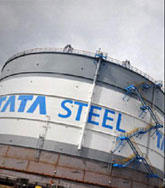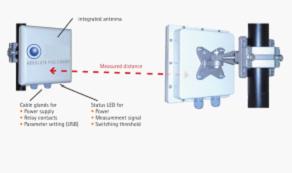Gas Holder Piston Deck Levelling

A gas holder is a large container in which gas is stored near atmospheric pressure at ambient temperatures. The volume of the container follows the quantity of stored gas, with pressure coming from the weight of a movable cap. Typical volumes for large gasholders are about 50,000 cubic metres, with 60 metre diameter structures. The Wiggins type gasholder uses a cylindrical-shaped sealing membrane, which provides an effective gas-tight seal between the gasholder shell and the internal piston to which the membrane is fastened. The sealing membrane is made from a textile reinforced polymeric compound, developed specifically for coke oven gas. By capturing coke oven gas effectively, steel plants can capitalise on its high calorific value to generate other forms of energy.
Piston
The gasholder piston moves up and down the inside of the shell as gas enters and exits the gasholder. The weight of the piston (less the weight of the level weights) produces the pressure at which the gasholder will operate.
The piston is designed to apply an equally distributed weight to ensure that the piston remains level at all times. The piston made up of the following sub-elements:
Piston deck
The outer annular area is formed from butt welded steel plates resting on steel section rest blocks. Lap welded steel infill plates form a dome profile to withstand the gas pressure in the gas space beneath it.
For higher pressure gasholders the infill plates are lap welded on both sides, whereas, low pressure gasholders are only welded on the top side. The fully welded piston deck forms a gas tight surface, which rests on the piston support structure when the gasholder is depressurised.
Laser reflector plates
Used to bounce the laser signal back to the laser instrument for levelling indication recording and piston level readings. In this case Moduloc have provided the MD3500-XT. (In addition the MD3500-1T-XT can be provided which is a with heater variant)
Improvements in the Operation of Coke Plants Through Alignment Process Optimization
The use of adequate technology in harsh environments such as coke plants can open the spectrum of potential applications aimed to improve different areas of the production process.
By implementing an accurate, adequate and reliable positioning system on door machines, pusher cars, hot cars or even PCMs, the alignment process can be optimized. By providing the machine operators a technological tool which avoids the need for visual checking (human or through video cameras), the alignment process gets improved not only from the operational stand point (time savings, human error minimization) but also from the safety and asset protection stand points.
The integration of the alignment system with other systems in the plant presents options for the implementation of further automated improvements like collision avoidance, schedule execution, performance checking, delay management and exceptional situation handling.
Application: Cars Collision Avoidance

By measuring the distance between two cars at a coke battery, a collision avoidance system can be implemented. Reliability of the measuring system is key for collision avoidance applications, so the operators are aware of the system status at all times.
For this reason, radar technology used in collision avoidance needs to provide some additional features other than just distance measurement information. Typically, for this type of application, a set of relay outputs are provided, signalling power conditions and health system conditions in order to warn operators upon any failure. Other relay signals may include different levels of closeness between cars, which may mean different warning levels for operators or even a stop signal sent to the car control system.
